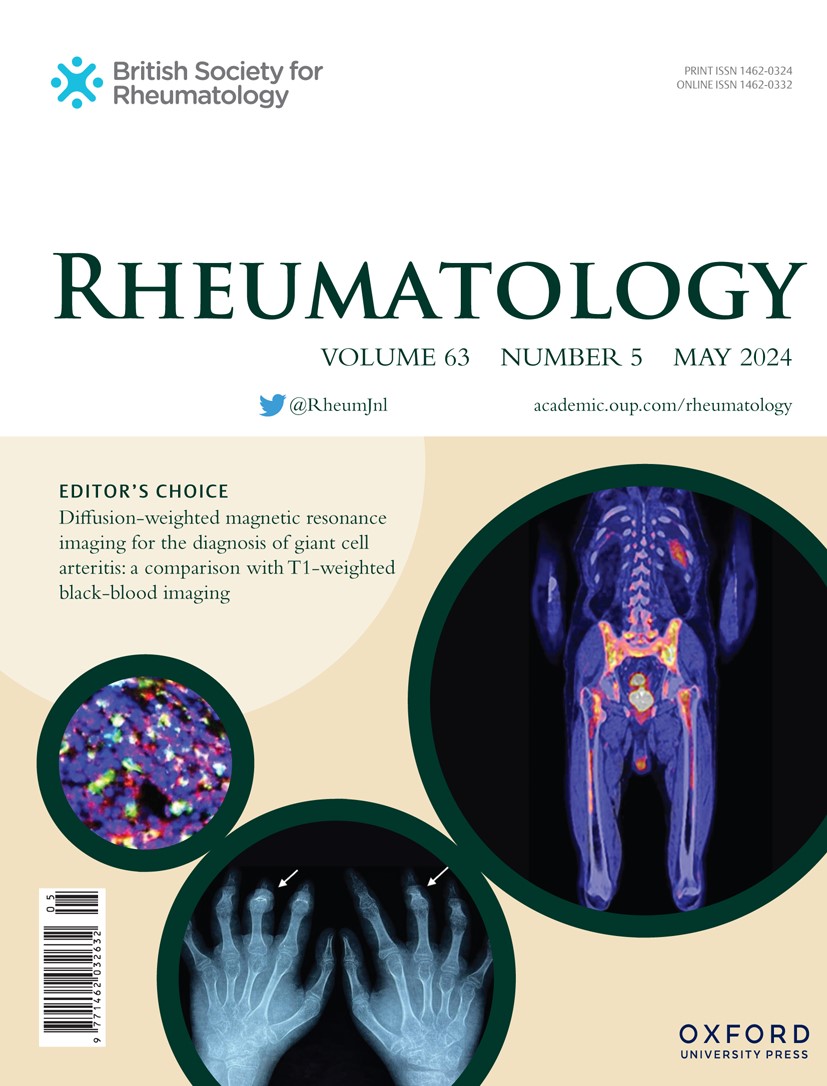E066 The use of zoledronate in CRMO: a small case series
IF 4.7
2区 医学
Q1 RHEUMATOLOGY
引用次数: 0
Abstract
Background/Aims Chronic Recurrent Multifocal Osteomyelitis (CRMO) or Chronic non-bacterial osteomyelitis (CNO) is a rare inflammatory bone disorder mainly affecting children and young adults. The time from onset of symptoms to diagnosis is often delayed due to variety of reasons. There is little evidence for treatment of this condition, which is often empiric, based on personal experience, expert opinion, case reports or small case series. In 2018, the Eurofever registry published the largest case series and complete remission of symptoms was largest in the group of patients treated with bisphosphonates (51%). Much of the available evidence about the use of bisphosphonates is with pamidronate. However, zoledronate has been increasingly used due to its efficacy in other bone disease, longer duration of action, and possibly fewer infusions. In this small case series, we aimed to review the response of patients with CRMO to zoledronate. Methods This was a retrospective study, collecting data from electronic medical records of 8 consecutive patients with CRMO treated with zoledronate by the Paediatric Rheumatology team at Nottingham Children’s Hospital since 2021. Results 8 patients treated with zoledronate were identified. Of these 3 (37.5%) were female and 5 (62.5%) were male. Additional demographic data was unavailable for 1 patient. In the remaining 7 patients the age of onset of symptoms ranged from 6 years to 14 years with a mean age of onset of 9 years. The length of symptoms before rheumatology review ranged from 2.5 months to 36 months with a mean of 13 months. The commonest sites involved were Femur (71%), followed by mandible (42%) and pelvis (29%). All 8 patients had received a trial of NSAIDS before receiving zoledronate. All patients received concurrent treatment with IV methylprednisolone along with zoledronate. The indications of zoledronate treatment were symptoms persisting despite NSAIDs and spinal lesions, even if asymptomatic. The protocol involves giving a single dose of zoledronate with subsequent doses given only if there is a clinical and / or radiological flare. No patients reported significant side effects. 7 (87.5%) patients had a response to zoledronate. 6 patients have received only 1 infusion of zoledronate. 1 patient received 3 zoledronate infusions in total with a second dose given 12 months after the first one and the third dose 16 months following the second. The other patient had two zoledronate infusions 12 months apart. Conclusion The data confirms previous evidence that bisphosphonates are a safe and effective treatment in children and adolescents with CRMO, with zoledronate specifically being effective without significant side-effects. As this is a retrospective study there were limitations to the data collected. Prospective studies looking at the treatment of CRMO are needed to help develop a standard approach to management of these patients. Disclosure M.C. Mackay: None. S. Deepak: None. K. Gargh: None. S. Rangaraj: None. K. Warrier: None.唑来膦酸钠在CRMO中的应用:一个小病例系列
背景/目的慢性复发性多灶性骨髓炎(CRMO)或慢性非细菌性骨髓炎(CNO)是一种罕见的炎症性骨疾病,主要影响儿童和年轻人。由于各种原因,从症状出现到诊断的时间往往会延迟。治疗这种疾病的证据很少,通常是经验性的,基于个人经验、专家意见、病例报告或小病例系列。2018年,欧洲热病登记处公布了最大的病例系列,在接受双磷酸盐治疗的患者组中,症状完全缓解最多(51%)。大部分关于双磷酸盐使用的现有证据都是帕米膦酸盐。然而,唑来膦酸盐由于其对其他骨病的疗效、较长的作用时间和可能较少的输液而越来越多地使用。在这个小病例系列中,我们旨在回顾CRMO患者对唑来膦酸盐的反应。方法回顾性研究,收集诺丁汉儿童医院儿科风湿病学团队自2021年以来连续接受唑来膦酸盐治疗的8例CRMO患者的电子病历数据。结果8例患者采用唑来膦酸钠治疗。其中女性3例(37.5%),男性5例(62.5%)。1例患者没有其他人口统计数据。其余7例患者出现症状的年龄从6岁到14岁不等,平均出现症状的年龄为9岁。风湿病学复查前的症状持续时间从2.5个月到36个月不等,平均为13个月。最常见的受累部位是股骨(71%),其次是下颌骨(42%)和骨盆(29%)。所有8例患者在接受唑来膦酸钠治疗前都接受了非甾体抗炎药的试验。所有患者同时接受静脉注射甲基强的松龙和唑来膦酸钠治疗。唑来膦酸钠治疗的适应症是尽管有非甾体抗炎药和脊柱病变,但症状持续存在,即使无症状。该方案包括给予单剂量唑来膦酸盐,只有在出现临床和/或放射耀斑时才给予后续剂量。没有患者报告有明显的副作用。7例(87.5%)患者对唑来膦酸钠有反应。6例患者仅接受1次唑来膦酸钠输注。1例患者共接受3次唑来膦酸钠输注,第二次在第一次输注后12个月,第三次在第二次输注后16个月。另一名患者间隔12个月输注两次唑来膦酸盐。结论该数据证实了先前的证据,即双膦酸盐是一种安全有效的治疗儿童和青少年CRMO的药物,特别是唑来膦酸盐有效且无明显副作用。由于这是一项回顾性研究,因此收集的数据存在局限性。需要对CRMO的治疗进行前瞻性研究,以帮助制定治疗这些患者的标准方法。麦凯:没有。迪帕克:没有。加格:没有。S. Rangaraj:没有。沃里:没有。
本文章由计算机程序翻译,如有差异,请以英文原文为准。
求助全文
约1分钟内获得全文
求助全文
来源期刊

Rheumatology
医学-风湿病学
CiteScore
9.40
自引率
7.30%
发文量
1091
审稿时长
2 months
期刊介绍:
Rheumatology strives to support research and discovery by publishing the highest quality original scientific papers with a focus on basic, clinical and translational research. The journal’s subject areas cover a wide range of paediatric and adult rheumatological conditions from an international perspective. It is an official journal of the British Society for Rheumatology, published by Oxford University Press.
Rheumatology publishes original articles, reviews, editorials, guidelines, concise reports, meta-analyses, original case reports, clinical vignettes, letters and matters arising from published material. The journal takes pride in serving the global rheumatology community, with a focus on high societal impact in the form of podcasts, videos and extended social media presence, and utilizing metrics such as Altmetric. Keep up to date by following the journal on Twitter @RheumJnl.
 求助内容:
求助内容: 应助结果提醒方式:
应助结果提醒方式:


